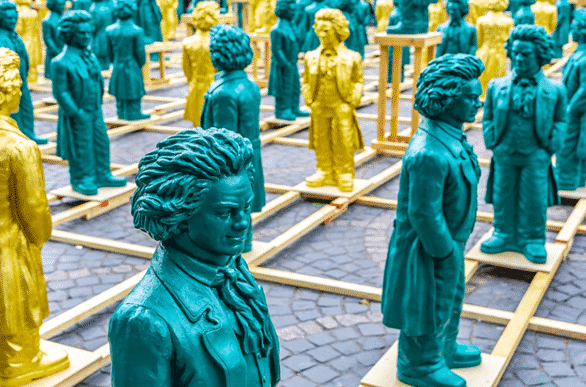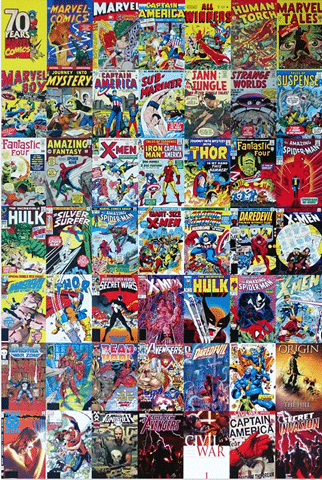Lessons from 19th-Century Germany and The Marvel Universe

His daily composing art is treasured 250 years later as the Münsterplatz, Bonn, Germany celebrated Beethoven’s 250th birthday in 2020. The composing genius rose above profound hearing loss to create some of his greatest pieces of music without “hearing as usual.”
It is easy to forget that Beethoven, widely regarded as the greatest composer who ever lived, divined much of his oeuvre after he had lost nearly all of his hearing.
In fact, the classical composer wrote one of his most famous works, the Moonlight Sonata, with failing hearing.
When the famed virtuoso’s hearing began to lapse, housekeepers watched with curiosity. He would grip a pencil in his mouth, placing the opposite end to the soundboard, then strike keys which allowed him to “feel” the music he was creating. His process retrained his brain to process values for sounds he could no longer hear.
Fast-forward a few-hundred years to Daredevil. Today we may be more familiar with the big-screen movie release or the Netflix Daredevil, but enigmatic cartoonist Stan Lee created the character in the 1960s.
When Superhero Daredevil became blind, his other senses heightened. He became able to hear accelerated heartbeats of liars, often unrevealed adversaries.
This radar sense alerted him of peoples’ approaching or proximate presence. His fingers could process printed words by his mere touching of the ink. He became a master at martial arts, hand-to-hand combat, and even marksmanship.
Composers and Comic Book Characters Informing After Hours Triage?
Beethoven and Daredevil alike innovated and explored how to heighten their abilities, amid unique challenges.
I submit that one’s being open to this concept informs the Art of Nursing for the remote triage nurse.
After hours Triage RNs for Home-Health and Hospice (HHH) are in place to serve patients, caregivers, and the whole care ecosystem from afar.
While some after-hours or daytime triage nurses have video communication, many operate from phone lines alone.
While many nurses are informed by Remote Patient Monitoring, others operate from phone lines alone.
How can we, like German super-composer Beethoven and Marvel Universe superhero Daredevil, tap our abilities to produce ongoing stellar results for patients, caregivers, and our healthcare team members?
What Is The Art of Nursing? How Does it Relate?
Many are familiar with ancient Chinese general Sun Tzu’s The Art of War, but may wonder what is The Art of Nursing..
What is “The Art of Nursing?”
It is actively, avidly leveraging one’s creativity and elevating one’s skills to profoundly contribute to care.
Author C.A. Jenner and the late NIH author Patsy H. Fasnacht, support this definition. They emphasize creativity as the element embodying nursing’s artistic side.
The NIH’s National Library of Medicine notes that nursing’s ”being a science and an art is commonly accepted.”
Home-Health and Hospice Telenursing and Creativity
For me, the Art of Nursing is ever-evolving.
It is, like Beethoven, our going beyond the limits of our physical “hearing” to invoking deeper listening of, to, and for patient vibrations. It is hearing the little things, what to Beethoven were tonal differences, to yield daily, profound Art of Nursing outcomes. It is, like Daredevil, developing super-keen skills to overcome challenges like human distraction or technological limitation of a phone call versus an in-person connection, and then have the outcomes exceed what might have been the practice of “care as usual.”
How can we, like German super-composer
Beethoven and Marvel Universe superhero
Daredevil, tap our abilities to produce
ongoing stellar results for patients, caregivers,
and our healthcare team members?

CareXM provides best-in-class phone triage for clients across the country. Recently, a hospice patient’s spouse called, concerned about his wife’s comfort.
He indicated she was constipated, had belly pain, and had not recently had a bowel movement.
The Practice of Nursing may have lead us to immediately jump to initiating a patient care plan for constipation.
Describe the pain and how it presents or feels.
Did the patient still exhibit symptoms of a UTI?
What medications was she prescribed?
Had she completed her prescription regimen?
Turns out, the patient had stopped taking her UTI meds. The nurse’s attentively, patiently, artfully listening resulted in the right plan: treating kidney infection.
The Mind-Body Connection and Creative Listening
I have been a nurse for 12 years and now oversee training for CareXM’s nationwide network of remote RNs managing calls 24/7/365 for some of the largest and smallest Home-Health and Hospice organizations in the country.
Our nurses, our clients, and our mutual patients are benefited by my unique background.
Prior to nursing, I was a body healer. I studied Kinesiology and Exercise Science at the collegiate level and supplemental Massage Therapy education, earning degrees and credentials in both sciences.
Every day, I bring my insights into listening to the body to our cadre of 100 business hours, after-hours and weekend RNs triaging calls for patients and caregivers.
UCLA psychology professor and researcher Albert Mehrabian famously proposed that 55% of communication is nonverbal, 38% is vocal, and 7% is words alone.
While there are various interpretations about, criticisms of, and updates to his 1970s theory, the point is clear: Non-verbal communication represents the majority of traditional human exchanges.
Being able to visually “see” situations over the phone and interpret other clues is akin to blind Daredevil’s initial plight which he transformed to superhero advantage for those he is caring for. It is akin to Beethoven’s critical thinking to leverage memory and new perception to genius.
In nursing, we are always learning, ever evolving. There is never an endpoint. This lifelong learning about care and caring is what attracts the curious nurse to the career.
The opportunity to regularly, joyously advance our critical-thinking and creativity skills we learned in nursing school to daily Art of Nursing is not just a career, it is an honor, a duty, and a delight.
Comments are closed.